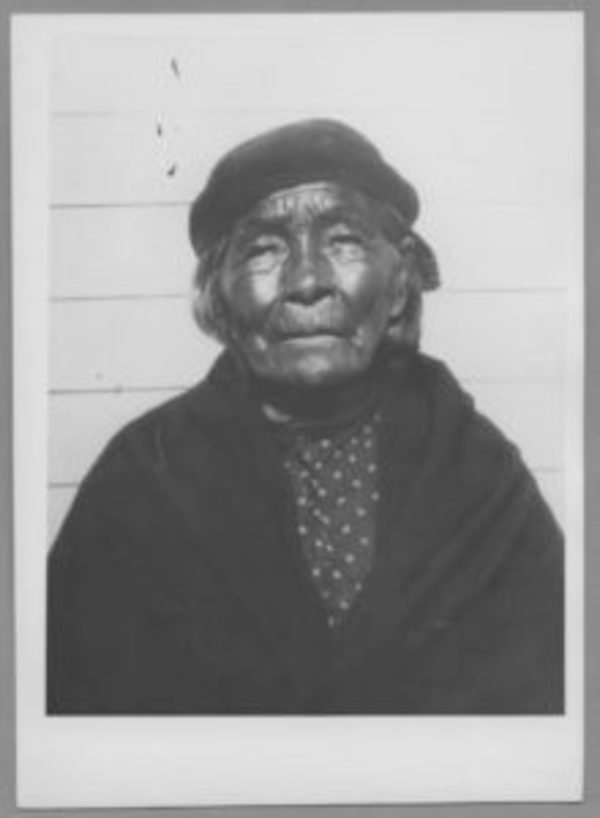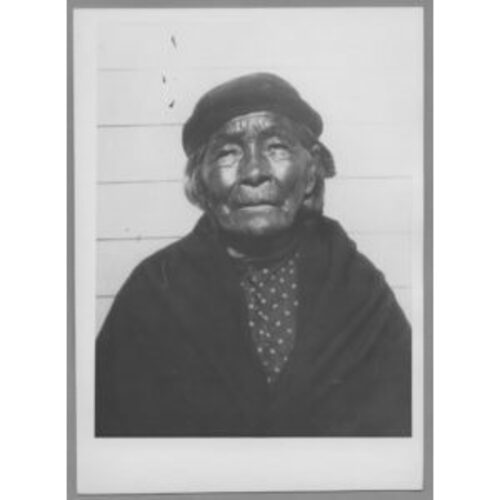
Source: Link
PIWAPISKUS, MARIE-ROSE (Opikokew), Plains Cree catechist and educator; b. c. 1840 in what is now central Saskatchewan, daughter of Piwapiskus (Piwabiskus; Wyabaskwek; Petit-Fer; Iron) and Sophie Missinagonessau; m. c. 1860 Louis (Jean-Louis) Opikokew (d. c. 1870) in Île-à-la-Crosse (Sask.), and they had two sons, Jean-Baptiste and Francis (François), who were born around 1863 and 1865 respectively; during her widowhood she adopted a daughter, Marie-Céleste (b. c. 1890); d. 5 June 1931 in Île-à-la-Crosse.
Known variously by different forms of the Cree name Piwapiskus, its French translation, Petit-Fer, and an English rendering, Iron, Marie-Rose Piwapiskus’s family left the plains for the boreal forest of what would become northwestern Saskatchewan after learning that Roman Catholic priests Louis-François Laflèche* and Alexandre-Antonin Taché* had established a permanent mission at Île-à-la-Crosse in 1846. Île-à-la-Crosse was a Hudson’s Bay Company trading hub, run at the time by Chief Factor Roderick McKenzie*, and had previously been ministered to by Father Jean-Baptiste Thibault*, who had recommended the establishment of missions in the area. According to the “Arbre généalogique” maintained by the Catholic Church there, Sophie Missinagonessau had been married twice and had three surviving children from each marriage: Raphaël, Catherine, Marie-Rose, William, Baptiste (Jean-Baptiste), and Judith (also called Esther and Isabelle). The priest who recorded these names did not identify which husband had fathered which child. It seems, however, that the local community recognized Piwapiskus as the father of all six children even though he may not have been the biological father of all of them.
The Piwapiskus family did not travel alone to Île-à-la-Crosse but were accompanied by another family, the Opikokews, led by respected Cree knowledge keeper and storyteller Bernard Opikokew and his wife, Marie Itchamipek. The close association between the Piwapiskus and Opikokew families, marked by their mutual relocation, was to be reinforced through a series of unions between their offspring. In addition to Marie-Rose, a son and another daughter of Sophie Missinagonessau Piwapiskus would be married to children of Bernard and Marie Opikokew: Raphaël to Euphémie and Judith to Joseph. From Île-à-la-Crosse the two families made their way to the shore of Canoe Lake, approximately 28 miles southwest of the new mission, where they subsisted by hunting, trapping, and fishing (and where Raphaël Piwapiskus would become a well-known chief). Along with other Cree and Dene in the area, they travelled to Île-à-la-Crosse every spring and autumn in the late 1840s and 1850s to trade furs for manufactured goods and to receive religious instruction and spiritual and liturgical services. It was during these trips that Marie-Rose was gradually catechized and ultimately baptized by Father Taché. Around 1860 she went to the mission to marry Louis Opikokew.
Louis died less than a decade later, leaving Marie-Rose to care for their young sons. Her family encouraged her to remarry, but the young widow was drawn to another option afforded by the recent establishment of a satellite mission at Canoe Lake. Launched in 1869 and officially consecrated in 1871, the Bienheureuse Marguerite-Marie mission was visited once or twice a year by a priest from Île-à-la-Crosse who would officiate at masses and administer the sacraments to the Catholic population over a few weeks at a time. These visits were too short and too infrequent for the priest to provide intensive religious instruction to local children. By the autumn of 1873 Marie-Rose had reached an agreement with the superior at Île-à-la-Crosse, Father Prosper Légeard, to run a day school from her home in exchange for an annual stipend. Under the terms of this arrangement, she would teach prayers, hymns, and the catechism in Cree while remaining unmarried and raising her own children.
Marie-Rose’s efforts produced impressive results and won high praise from Catholic missionaries. She taught primarily in the winter months when Cree hunting and trapping families gathered in large numbers at Canoe Lake and their children were expected to learn from elders, family friends, and extended kin. After only three winters, Légeard observed in the spring of 1876 that many of Marie-Rose’s pupils could recite the catechism by heart: “This is the first time, I believe, that we have in our missions sauvage children who have been taught the catechism inside and out. No one else would have thought of attempting this extremely difficult task; our little schoolmistress, with her willingness, her perseverance, and also the good Lord’s help, has stayed the course.” Légeard expressed equal admiration for Marie-Rose’s success in teaching her pupils to read and write in the Cree-syllabic system developed by Methodist missionary James Evans* and adopted by his Catholic and Anglican counterparts. Several of her pupils sent handwritten greetings and prayers to the priests at Île-à-la-Crosse in the late 1870s and the 1880s.
In addition to working with children, Marie-Rose served as an adviser to many adults. From the founding of the Bienheureuse Marguerite-Marie mission, she offered instruction in Cree to priests ministering in the broad vicinity of Île-à-la-Crosse and assisted them in composing and revising their Cree-language sermons, hymns, and prayers. She hosted these priests in her home at Canoe Lake and provided them with food, shelter, and warm clothing during working sessions that could extend over several days at a time. Concurrently, Marie-Rose played an active role in evangelizing Cree women: she was credited, most notably, with converting an elderly woman from Waterhen Lake who for years had shunned contact with priests but who finally asked to be baptized in 1882. By the turn of the century, Marie-Rose was renowned throughout northwestern Saskatchewan for her wisdom, faith, and dedication to teaching. She was known more commonly by titles of respect than by her birth or baptismal name: Catholic missionaries called her la Maîtresse d’école (“the Schoolmistress”); the Cree called her Okiskinohamakew (“the Teacher”).
After experiencing hearing and vision loss in the 1900s and early 1910s, Marie-Rose was compelled to close her school around 1915. Yet she continued her work with priests into the late 1920s. She also attended the catechism lessons that they gave to local children, providing linguistic assistance to them and doctrinal clarification and interpretation to the pupils. Marie-Rose died in her nineties at the Île-à-la-Crosse hospital on 5 June 1931 and was buried in the cemetery at Canoe Lake. Inscribed on her tombstone were her title in Cree – Okiskinohamakew – and a brief account of her conversion and vocation. The Catholic Church eulogized her as a true apostle and extolled her contributions to the evangelization of First Nations and Métis in western Canada. Among the Cree, her legacy may be more complicated since it is bound up with a history of missionization and colonialism, but there can be little doubt that she had succeeded in giving Christianity resonance, meaning, and value for many of her people. Her story is instructive as well in that it speaks in part to the family connections, mutual support, and shared responsibilities that characterized the Cree community.
Records relating to Marie-Rose Piwapiskus’s early life, among them the registrations of her baptism and marriage, were destroyed in the fire that engulfed the mission at Île-à-la-Crosse on 1 March 1867. This biographical article is, by necessity, based on records dating from after the fire.
Centre du Patrimoine (Winnipeg), 0092/001 (Codex historicus de l’Île-à-la-Crosse, 1845–97); 0092/002 (Codex historicus de l’Île-à-la-Crosse, 1898–1928); 0092/008 (Arbre généalogique (Liber animarum) Île-à-la-Crosse, 1845–97). Church of Jesus Christ of Latter-day Saints, “Église catholique, Mission de Saint-Jean-Baptiste, Île-à-la-Crosse, Saskatchewan,” registres paroissiaux, 1867–1912: www.familysearch.org/search/catalog/48453?availability=Family%20History%20Library (consulted 13 Dec. 2021). Grey Nuns Arch. (Montreal), L018, F, 1, 15 (Annales de l’établissement des sœurs grises à l’Île-à-la-Crosse, 1883–85, 2 vols.). LAC, R233-37-6, Territories, dist. Unorganized territories (206), subdist. Athabasca (A), div. 8: 13–14. Oblate General Arch. (Rome), PF – XVIII/4 (letters of R. P. Prosper Légeard). PAA, O.M.I. coll., Acc. 84.400, box 34, items 986–87 (Bishop Vital-Justin Grandin, “Missions et résidences du diocèse de St. Albert,” 1882–83). L. A. Erickson, “‘Bury our sorrows in the Sacred Heart’: gender and the Métis response to colonialism: the case of Sara and Louis Riel, 1848–83,” in Unsettled pasts: reconceiving the west through women’s history, ed. Sarah Carter et al. (Calgary, 2005), 17–46. T. P. Foran, Defining Métis: Catholic missionaries and the idea of civilization in northwestern Saskatchewan, 1845–1898 (Winnipeg, 2017). Germain Lesage, Capitale d’une solitude (Ottawa, 1946). P[rosper] Légeard, “Extrait d’une lettre au R. P. Martinet,” Missions de la Congrégation des missionnaires oblats de Marie Immaculée (Paris), 15 (1877): 306–28 (this letter is also excerpted in Annales de la propagation de la foi and cited below); “Lettre au R. P. Martinet, secrétaire général,” Missions de la Congrégation des missionnaires oblats de Marie Immaculée, 12 (1874): 529–45; “Missions d’Amérique,” Annales de la propagation de la foi (Lyon, France), 49 (1877): 440–54; “Mission de Saint-Albert,” Missions de la Congrégation des missionnaires oblats de Marie Immaculée, 13 (1875): 486–92. Louis Moraud, “Histoire d’une maîtresse d’école,” Petites Annales des oblats de Marie Immaculée (Paris), février 1921: 178–82. Louis Soullier, Vie du révérend père Légeard, missionnaire oblat de Marie Immaculée (Paris, [1886]).
Cite This Article
Timothy P. Foran and Brenda Macdougall, “PIWAPISKUS, MARIE-ROSE (Opikokew),” in Dictionary of Canadian Biography, vol. 16, University of Toronto/Université Laval, 2003–, accessed January 1, 2026, https://www.biographi.ca/en/bio/piwapiskus_marie_rose_16E.html.
The citation above shows the format for footnotes and endnotes according to the Chicago manual of style (16th edition). Information to be used in other citation formats:
| Permalink: | https://www.biographi.ca/en/bio/piwapiskus_marie_rose_16E.html |
| Author of Article: | Timothy P. Foran and Brenda Macdougall |
| Title of Article: | PIWAPISKUS, MARIE-ROSE (Opikokew) |
| Publication Name: | Dictionary of Canadian Biography, vol. 16 |
| Publisher: | University of Toronto/Université Laval |
| Year of publication: | 2023 |
| Year of revision: | 2023 |
| Access Date: | January 1, 2026 |



